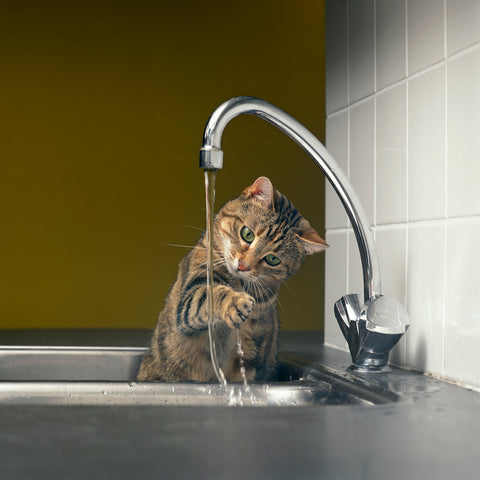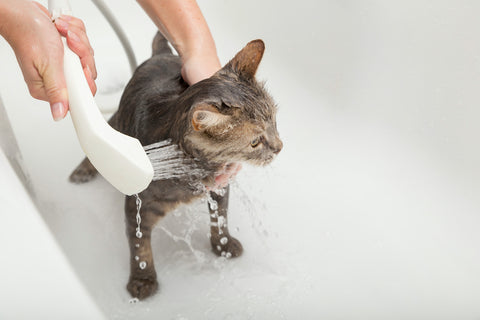Why Are Cats Afraid of Water? Exploring the Feline Hydrophobia
Cats are known for their graceful and independent nature, but there's one thing that many cat owners can attest to: their feline friends' aversion to water. From the mere sight of a bathtub to the sound of running water, many cats will go to great lengths to avoid getting wet. But have you ever wondered why cats seem to be so afraid of water?
In this blog article, we'll explore some of the reasons behind this common feline behavior.

The Real Reason Cats Are Afraid of Water
Evolutionary Origins:
One theory behind cats' fear of water dates back to their wild ancestors. Most domestic cats are descended from desert-dwelling species, and water sources were often scarce in their natural habitats. As a result, cats didn't have a need to develop a natural affinity for water. Over time, this aversion to water has become ingrained in their instincts.
Fur and Temperature Regulation:
Cats are meticulous groomers, and their fur is crucial for regulating their body temperature. Wet fur loses its insulating properties, making a cat feel cold and uncomfortable. This discomfort might be another reason why cats avoid water whenever possible.
Lack of Control:
Cats are creatures of habit and prefer to be in control of their environment. When placed in water, they may feel vulnerable and unable to escape easily. This loss of control can trigger anxiety and fear in many cats.
Sensitive Ears:
Cats have highly sensitive ears, which allow them to hear sounds at frequencies that are beyond human perception. The sound of running water in a sink or a bathtub can be quite loud and startling for a cat, making them associate water with an unpleasant experience.
Natural Instincts:
Cats are natural hunters, and their instincts drive them to stay as stealthy and dry as possible when stalking prey. Water can hinder their ability to move quietly and catch their quarry. This instinctual behavior could explain their aversion to water.
Lack of Exposure:
If a cat is not exposed to water from a young age, they may develop a fear of it. Cats that have positive early experiences with water, such as being bathed gently and rewarded afterward, may be less fearful of water in adulthood.
It's important to note that not all cats are equally afraid of water. Just as with humans, individual personality traits can play a significant role in a cat's reaction to water. Some cats may be more curious and open to water-related experiences, while others may be more cautious and fearful.
If you ever need to bathe your cat or introduce them to water-related experiences, it's essential to do so gently and positively to minimize their fear and stress. Understanding and respecting your cat's aversion to water is crucial for maintaining a harmonious relationship with your feline companion.
Is It Bad to Bathe Your Cat?
Bathing your cat is not necessarily bad, but it's generally not something that should be done frequently. Cats are known for their meticulous grooming habits and are usually quite capable of keeping themselves clean. However, there are situations where giving your cat a bath may be necessary or beneficial.
Here are some guidelines to consider:
Medical Reasons: If your cat has a medical condition that affects their ability to groom themselves properly, such as obesity or arthritis, they may benefit from an occasional bath to keep their fur clean and prevent matting.
Allergies: If someone in your household has allergies to cat dander, regular bathing can help reduce the amount of allergens in your cat's fur.
Flea Control: In cases of severe flea infestations, a veterinarian may recommend giving your cat a flea bath using a specially formulated flea shampoo. Always consult with your vet before using any flea products on your cat.
Eliminating Odors: If your cat gets into something smelly or has an accident outside the litter box, a bath may be necessary to remove unpleasant odors.
Long-Haired Breeds: Long-haired cat breeds, such as Persians or Maine Coons, may require occasional baths to prevent matting and maintain their coat's health.
When giving your cat a bath, it's essential to use a cat-specific shampoo, as human shampoos can be too harsh and may irritate their skin.

Tips for Bathing a Cat Who Hates Water
Bathing a cat who hates water can be a challenging task, but with patience, preparation, and some strategies to make the experience less stressful, it can be done. Here are some tips for bathing a cat who dislikes water:
Prepare Everything in Advance:
Gather all your supplies before you start, including cat-specific shampoo, towels, a non-slip mat for the tub or sink, and a soft brush.
Place everything within easy reach, so you don't have to leave your cat unattended.
Choose the Right Location:
Use a sink or a small plastic tub instead of a bathtub, as it can feel less intimidating for your cat.
Put a rubber mat at the bottom to give your cat better footing and prevent slipping.
Trim Your Cat's Nails:
Trim your cat's nails before the bath to reduce the risk of scratches if they become agitated.
Make the Water Comfortable:
Use lukewarm water, as cats are sensitive to temperature changes. Test the water temperature with your wrist to ensure it's not too hot or cold.
Stay Calm and Gentle:
Approach your cat calmly and speak in soothing tones. Cats can pick up on your anxiety, so try to stay relaxed.
Use slow, gentle movements to avoid startling your cat.
Use a Washcloth or Cup:
Wet your cat gradually using a washcloth or a cup of water rather than pouring water directly onto them, which can be distressing.
Use Cat-Specific Shampoo:
Use a cat-specific, hypoallergenic shampoo, and dilute it with water to make it easier to rinse out.
Be Efficient:
Work quickly but gently. Apply the shampoo, lather, and rinse as efficiently as possible to minimize the time your cat spends in the water.
Keep Their Face Dry:
Be especially cautious around your cat's face and ears. Use a damp washcloth to clean their face instead of submerging it in water.
Positive Reinforcement:
Offer treats and praise throughout the process to create positive associations with the bath.
Have a Towel Ready:
Have a soft, warm towel nearby to wrap your cat in as soon as you finish rinsing. This helps them dry off and stay warm.
Post-Bath Comfort:
After the bath, ensure your cat is in a warm, draft-free environment until they are completely dry. You can use a hairdryer on a low heat setting if your cat tolerates it, but avoid high heat.
Gradual Introduction:
If your cat strongly dislikes baths, consider introducing them to water gradually. Start with just a wet washcloth and slowly progress to a full bath over several sessions.
Seek Professional Help:
If your cat's fear of water is extreme and you're concerned about their stress or safety, consider enlisting the help of a professional groomer or your veterinarian.
Remember that some cats may never become comfortable with water, and in such cases, it's best to explore alternative methods for keeping them clean and healthy, such as using waterless cat shampoos or regular brushing to remove dirt and loose fur. The key is to prioritize your cat's comfort and well-being throughout the process.
Leave a comment
